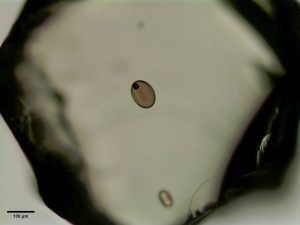Diffusive Re-equilibration of Olivine-Hosted Melt Inclusions
Volatiles—such as water and carbon dioxide—play a central role in the generation and evolution of magmas deep within the Earth. Further, the concentration of volatiles in magmas stored in crustal reservoirs plays an important role in determining the explosivity of volcanic eruptions. Given that 500 million people live in close proximity to an active volcano, it is especially important to have an accurate assessment of the pre-eruptive volatile contents of basaltic magmas. However, determining the pre-eruptive volatile contents of erupted lavas has proven to be particularly challenging because of the extensive degassing that occurs during ascent and eruption. Olivine-hosted melt inclusions provide a direct source of information on the pre-eruptive volatile contents of degassed magmas because the strength of the host crystal protects the melt inclusion from the decompression experienced by the entraining magma. The principal source of uncertainty involved with deriving pre-eruptive volatile concentrations from olivine-hosted melt inclusions is the potential for loss or gain of hydrogen by diffusion through the host olivine. In this study, we used a combination of experiment and theory to understand the mechanism responsible for post-entrapment modification of volatile concentrations in olivine-hosted melt inclusions. Experiments conducted on natural melt inclusions demonstrate clearly that significant diffusive modification of water in melt inclusions can occur within hours. If a melt inclusion is quenched while diffusive loss is occurring, the process can be identified through an elevated deuterium-to-hydrogen ratio within the inclusion. This occurs because hydrogen diffuses more rapidly through the host olivine than deuterium but, given enough time for total re-equilibration, the signal will be erased. Our results also demonstrate that the oxidation state of iron in olivine-hosted melt inclusions – an indicator of the fugacity of oxygen – can be modified by diffusive processes on similarly short timescales. Finally, our results demonstrate that the loss of water from melt inclusions is capable of producing a significant pressure decrease. This pressure decrease causes carbon dioxide to exsolve from the included melt, forming a vapor bubble. This can potentially lead to significant underestimates of the pre-eruptive carbon dioxide concentration of the magma. We developed a numerical model that describes diffusive loss of water from olivine-hosted melt inclusions, as well as fractionation of deuterium from hydrogen, and the sequestration of carbon dioxide into a vapor bubble. This model provides a tool for understanding the post-entrapment modification of volatiles in olivine-hosted melt inclusions and, thereby, improves our estimates for pre-eruptive volatiles.
Funding for this research is provided by The National Science Foundation (NSF EAR-0948666).
